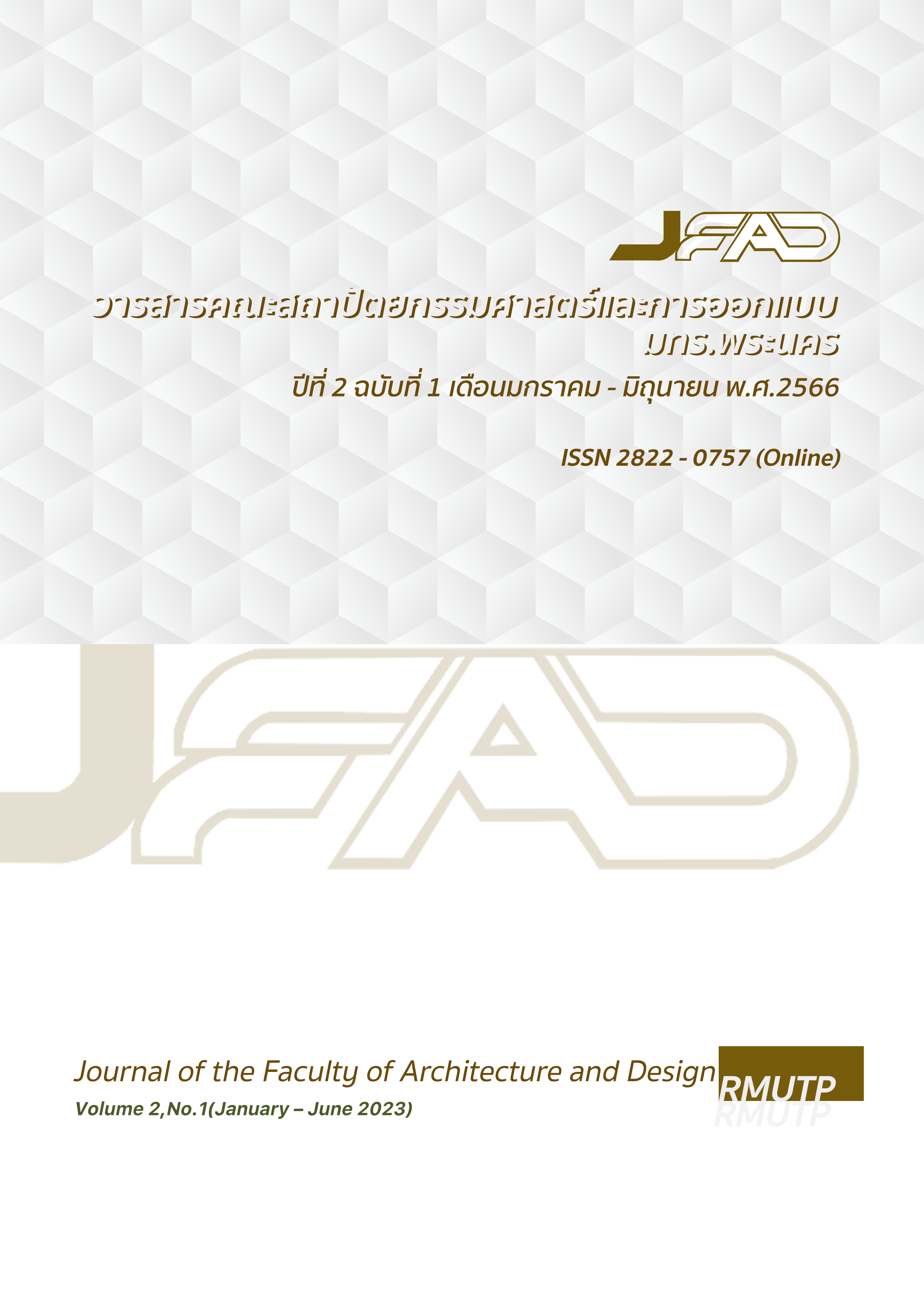ลักษณะทางกายภาพของแอร์บีเอ็นบีระดับไฮเอนด์และลักชูรี่ในกรุงเทพฯ ชั้นใน ความแตกต่างระหว่างอพาร์ตเมนต์และคอนโดมิเนียม
Main Article Content
บทคัดย่อ
บทความนี้นำเสนอลักษณะทางกายภาพของแอร์บีเอ็นบีประเภทอพาร์ตเมนต์และคอนโดมิเนียม ตามระดับคุณภาพที่พบมากที่สุดในแพลตฟอร์ม โดยสำรวจคุณลักษณะทางสถาปัตยกรรมและการตกแต่งภายใน ได้แก่ 1) อาคารและการตกแต่งภายนอก 2) หน่วยที่อยู่อาศัยและองค์ประกอบ 3) สาธารณูปโภค สาธารณูปการ และการตกแต่งภายใน และ 4) พื้นที่ใช้สอยส่วนกลาง จากกลุ่มตัวอย่างทั้งหมด 250 ตัวอย่าง แบ่งสัดส่วนสอดคล้องตามจำนวนประชากรแอร์บีเอ็นบีในเขตวัฒนาและคลองเตย ผู้วิจัยใช้การวิจัยแบบผสม โดยเชิงคุณภาพเป็นการวิเคราะห์คุณลักษณะทางสถาปัตยกรรมของแอร์บีเอ็นบี และบันทึกข้อมูลในแบบสำรวจเพื่อวิเคราะห์เชิงสถิติโดยใช้ค่าสถิติเพียร์สัน ไคร์สแควร์ ในการทดสอบความสัมพันธ์ระหว่างคุณลักษณะแต่ละด้านของอพาร์ตเมนต์และคอนโดมิเนียมแต่ละระดับคุณภาพ
ผลการศึกษาพบว่าระดับคุณภาพที่พบมากที่สุดทั้งของอพาร์ตเมนต์และคอนโดมิเนียม คือ ไฮเอนด์ ซึ่งตรงกับที่อยู่อาศัยระดับราคาปานกลางค่อนไปทางสูง และลักชูรี่ ซึ่งตรงกับที่อยู่อาศัยระดับราคาสูง แอร์บีเอ็นบีอพาร์ตเมนต์มีอายุอาคาร 11-20 ปี ในขณะที่คอนโดมิเนียมส่วนมากมีอายุอาคารน้อยกว่า 10 ปี ทำให้มีพื้นที่ส่วนกลาง ได้แก่ สวนและพื้นที่พักผ่อน ลอบบี้ ฟิตเนส สระว่ายน้ำ มีคุณภาพดีกว่าแอร์บีเอ็นบีอพาร์ตเมนต์ รูปแบบและขนาดห้องที่พบมากที่สุดคือสตูดิโอและหนึ่งห้องนอน ขนาดไม่เกิน 31 ตร.ม. มีผนังกั้นห้องนอนแยกเป็นสัดส่วน มีห้องครัวและอุปกรณ์ทำครัว ห้องน้ำและห้องสุขาแยกเป็นส่วนแห้งและเปียกอย่างชัดเจน รูปแบบการตกแต่งที่พบบ่อยคือคลาสสิค ร่วมสมัย และมินิมอล โดยใช้โทนสีอ่อนหรือโทนสีสว่าง ทั้งนี้ คุณลักษณะที่แตกต่างกันอย่างชัดเจนระหว่างแอร์บีเอ็นบีอพาร์ตเมนต์และคอนโดมิเนียมทั้งสองระดับคุณภาพ คือ ขนาดห้อง โดยระดับลักชูรีจะมีขนาดห้องที่กว้างกว่าไฮเอนด์อย่างมีนัยสำคัญทางสถิติที่ระดับความเชื่อมั่น 0.01 บทความนี้เสนอแนะให้เจ้าของอสังหาริมทรัพย์ที่มีห้องที่ไม่ถูกใช้งานและต้องการปรับปรุงเพื่อนำเข้าเป็นที่พักในธุรกิจแอร์บีเอ็นบีปรับปรุงห้องโดยแบ่งเป็นหนึ่งห้องนอน ขนาดไม่เกิน 30 ตร.ม. และตกแต่งสไตล์ร่วมสมัย โดยใช้โทนสีสว่างเพื่อให้ตรงตามลักษณะห้องที่พบมากที่สุดในตลาดปัจจุบัน
Article Details

This work is licensed under a Creative Commons Attribution-NonCommercial-NoDerivatives 4.0 International License.
Copyright (c) 2023 : คณะสถาปัตยกรรมศาสตร์และการออกแบบ มหาวิทยาลัยเทคโนโลยีราชมงคลพระนคร
References
Airbnb. (2022). Listings profile. Accessed by https://www.airbnb.com.
Barron, K., Kung, E. & Proserpio, D. (2017). The sharing economy and housing affordability: Evidence from Airbnb. Available at: https://ssrn.com/abstract1⁄43006832
Barron, K., Kung, E. & Proserpio, D. (2021) The Effect of Home-Sharing on House Prices and Rents: Evidence from Airbnb. Marketing Science 40(1):23-47.
Belk, R. (2014). You are what you can access: Sharing and collaborative consumption online, Journal of Business Research, 67(8), 1596–1600.
Botsman, R. & Roger, R. (2010). What's mine is yours: The rise of collaborative consumption. New York: Harper Collins.
Forbes. (2021). “What’s Happening With Airbnb Stock?” retrieved from https://www.forbes.com/sites/greatspeculations/2021/09/10/whats-happening-with-airbnb-stock/?sh=5c0d5fb82565
Garcia-Lopez, M-A., Jofre-Monseny, Martinez-Mazza, R & Segu, A. (2020). Do short-term rental platforms affect housing market? Evidence from Airbnb in Barcelona. Journal of Urban Economics. 119(2020), 103278
Gunter, U., & Önder, I. (2018). Determinants of Airbnb demand in Vienna and their implications for the traditional accommodation industry. Tourism Economics, 24, 270–293.
Gunter, U., Önder, I. & Zekan, B. (2020). Modeling Airbnb demand to New York City while employing spatial panel data at the listing level, Tourism Management, 77(2020). DOI: https://doi.org/10.1016/j.tourman.2019.104000
Horn, K. & Merante, M. (2017). Is home sharing driving up rents? Evidence from Airbnb in Boston, Journal of Housing Economics, 38, 14–24.
Joshi, A. (2018). Regulating an Infrastructuralised Airbnb: Organisational, Regulatory and Civil Society Challenges and Responses. Policy & Politics Conference 2018 (online), Oxford Internet Institute, University of Oxford. 20 September 2018, Oxford, United Kingdom. Available at https://www.researchgate.net/publication/328809910_Regulating_an_ Infrastructuralised_Airbnb_Organisational_Regulatory_and_Civil_Society_Challenges_and_Responses (conference paper)
Kim, Y., Li, H. & Srinivasan, K. (2019). Market shifts in the sharing economy: The impact of Airbnb on housing rentals. Available at SSRN: https://ssrn.com/abstract=3435105 or http://dx.doi.org/10.2139/ssrn.3435105
Khotcharee, Q. & Fukushima, S. (2022). Emergence of Peer-to-Peer Accommodation Sharing in Bangkok: The Case of Airbnb and Implications for Housing Market Distortion, Urban and Regional Planning Review, 2022(9), 200-221.
Khotcharee, Q. & Fukushima, S. (2023). The Conversion Tendency of Rental Housing to Airbnb Properties in the Tourism-Centric Districts in Inner Bangkok, Urban and Regional Planning Review, 2023(10), 243-262.
Liu, S., Q. & Mattila, A., S. (2017). Airbnb: Online targeted advertising, sense of power, and consumer decisions. International Journal of Hospitality Management, (60), 33-41.
Lutz, Z & Newlands, G. (2018). Consumer segmentation within the sharing economy: The case of Airbnb. Journal of Business Research, 88, 187–196. doi: 10.1016/j.jbusres.2018.03.019
Magno, F. (2018). Accommodation prices on Airbnb: effects of host experience and market demand. The TQM Journal, 30(5), 608-620.
Ministry of Tourism and Sports. (2019). Domestic Tourism Statistics Q1-Q4 (Classify by region and province), retrieved from https://www.mots.go.th/more_news_new.php?cid=618
NHA (National Housing Authority). (2019). Household Income Estimation by NHA Income Classification (2019-2037), Retrieved from https://gdcatalog.nha.co.th/dataset/ f5969cbf-bcca-4f7a-bc8c-227cef87d16a/resource/a7c126c9-f6be-47e5-9f9a-a2759ff52229/download/-2562-2580-21_04.xlsx
Teubner, T., Hawlitschek, F., & Dann, D. (2017). Price determinants on Airbnb: How reputation pays off in the sharing economy, Journal of Self-Governance and Management Economics, 5(4), 53-80.
Wachsmuth, D. & Weisler, A. (2018). Airbnb and the rent gap: Gentrification through the sharing economy, Environmental and Planning A: Economy and Space, 50(6), 1147-1170.
ดวงฤทัย ตี่สุขและจันทนี เพชรานนท์. “การพัฒนารูปแบบสถาปัตยกรรมภายในห้องชุดพักอาศัยคอนโดมิเนียมในเขตกรุงเทพมหานคร.” The 6th Built Environment Research Associates Conference 2015 (BERAC6), คณะสถาปัตยกรรมศาสตร์และการผังเมือง มหาวิทยาลัยธรรมศาสตร์, ปทุมธานี, วันศุกร์ที่ 17 กรกฎาคม 2558.Retrieved from https://www.berac.tds.tu.ac.th/proceedings_files/berac6/04_Design.pdf

